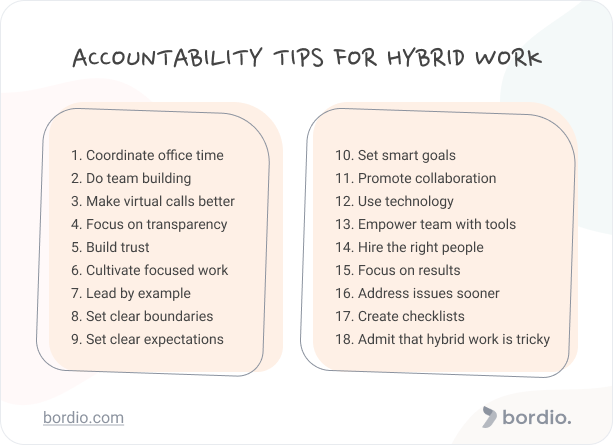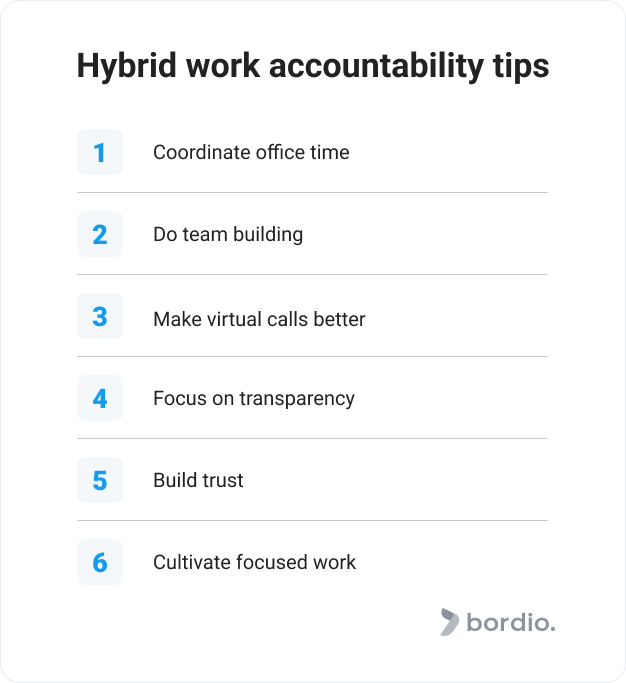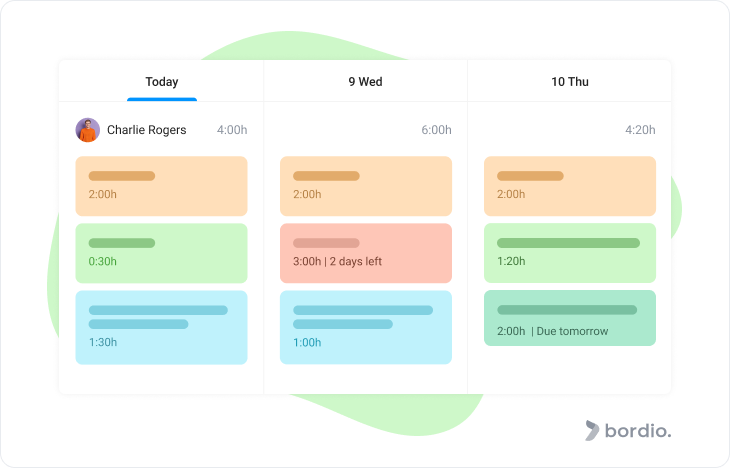Hybrid work represents the best of two worlds. You can do deep focus work in a peaceful home and come to the office for meetings and other interpersonal work.
The skepticism that has long surrounded hybrid and remote work has been debunked with pandemic reality proving that you can be just as productive (if not more) without sitting at your office desk Monday to Friday and which of the time to perform work remotely using the necessary tools for this purpose, such as a team’s time planner.
It looks like remote work is with us for a long time, as many people simply disagree to go back to a traditional office-based 9-to-5. And while both work styles are great, a global shift to combining the two ultimately comes with new challenges. One of the challenges is accountability which some managers and employees themselves fear will be an issue.
In this article, we will go into detail about the meaning of hybrid work, what it constitutes, and how to maximize its benefits. We will cover potential productivity and accountability risks associated with hybrid work. We’ll offer our solutions and recommendations that, hopefully, will allow everyone who reads our blog to build an unmatched team accountability culture and make the most of the hybrid work schedule.
What is hybrid work?
Hybrid work is a flexible model that combines in-office and remote work.
There are many ways that hybrid work can be organized. Sometimes, hybrid teams are asked to be in the office on certain days or hours, other times they are free to choose if and when they come. Depending on the company, there will be a different level of flexibility but the general rule is that there should be some time that remote employees spend in the office building.
Benefits of hybrid work
Hybrid working has many benefits that can make the working process much more productive and enjoyable for managers and the entire team.
1. Higher employee satisfaction
Remote workers often report higher job satisfaction rates because they have more flexibility which allows them to build healthy daily routines and achieve a better work-life balance.
Remote teams can make their daily to-do lists work for them and fit in more activities in the day which makes them happier. Previously, if you had no work somewhere in the middle of the day, you would resort to mindless email scrolling, chit-chat, or yet another coffee cup. Now employees can tailor their work to their needs and spend such slow times doing chores, working out, cooking a nourishing meal, or maybe taking a nap. If balanced well, all that can be done with no negative impact on productivity and professional goals that is time progress tracker. Of course you will free up time in your free schedule maker if you perform daily tasks from your work daily schedule maker.
A hybrid team would be able to enjoy all the perks that remote workers get, plus they would have access to socializing with their team, working on projects together, and being creative, boosting their motivation and spirits. If you only come to the office for team meetings to partner and collaborate, and can do the focused work at home or in an alternative remote setting where nobody bothers you, then your productivity and time management go up, and the number of wasted hours decreases, making you more happy and satisfied with work overall.
Moreover, hybrid work eliminates many hours of commute, freeing up time for hobbies or a few extra hours of sleep. If you just have to drive to the office once a week, you can save one to three hours each day that would normally be spent on a highway or in a traffic jam.
2. Reduced costs
When we mention reduced costs, we are talking about both the company and an employee.
Businesses can spend less cash on office space, utilities, and coffee for the team. Employees, in turn, can save on gas and public transportation, eat homemade meals instead of getting lunch in cafes, and spend less on clothing and cosmetics.
3. Better productivity and time management
Remote teams can come to the office on certain dates and have meetings and brainstorming sessions, maximizing their time together, and fostering collaboration, and bonding in general. You can use remote team management software to get the job done.
Then in the remote environment, they can do deep work that is hard to accomplish in the office where there’s constant chatting and group coffee breaks distracting even the most stoic employees.
Naturally, there are pros and cons to remote work and some employees would get most productive in the office setting. If that’s your case – then maybe you should stick to a traditional office-based work environment. However, a lot of people can benefit from a hybrid working process, and we see no reason why they shouldn’t be able to work like that.
How to make the most of the hybrid work and foster accountability
Hybrid work has many benefits to offer but it takes planning and intentional action to make the most of it. Team accountability is a big concern in the hybrid work scenario and it depends largely on how you build the processes.
There is a widespread idea that motivation doesn’t work as much as the correctly built work environment does. Similarly here, if you organize your hybrid workplace to support accountability and hard work, then that’s what you’ll get.
Tip: have a look at our staying productive at home article with tips for both work and leisure time.
Here are some tips on how you can boost employee accountability through indirect choices you make and processes you think through:
#1 Coordinate office time
If you are a project manager or a team leader, make sure you coordinate your remote teams’ office time to maximize employees’ interaction. It’s much better if your team members share at least some of their office time as they can catch up and collaborate.
If syncing everyone’s online calendar planners is not possible right now, make sure everyone joins for key meetings and events, like Sprint Review sessions in Scrum. Although you can always use simple best pm tools from Bordio, such as the handy weekly schedule maker online or free time organizer.
Important note: make sure you consider everyones’ preferences and remain flexible to accommodate them all (within reason).
#2 Team building
Focus on team-building activities when everyone is in the office. It doesn’t have to be a 3-day corporate kickoff but an informal team lunch or a small cakes and coffee break after an important project milestone is achieved and they can be entered into digital daily planners. Don’t forget about celebrations like birthdays, weddings and anniversaries.
#3 Support virtual meetings too
When your remote team is spread out, think about ways to make virtual meetings cozier and more fun. Try ice breaker games from our guide for chilled and pleasant Zoom meetings with high employee engagement.
#4 Make transparency a priority
Sometimes when people work on hybrid schedules, there can be misunderstandings and mistrust around how much someone works and contributes. It’s obviously not good and has to be prevented.
There are some ways to do that: make calendars and digital weekly planners public, create team dashboards, write a communication plan, and schedule daily stand-up meetings over Zoom or in corporate chat.
Tip: Use time and project management software for transparency. Bordio, for example, has public calendars where both project managers and remote teams can see everyone’s tasks, events, and meetings.
#5 Build trust across all boards
No micromanagement for bosses. Self-discipline for employees.
Share clear guidelines and rules on the work process and let the remote team work independently controlling them only by remote work collaboration tools. There’s nothing quite as annoying and demotivating as feeling like someone doesn’t trust you to do your job, especially when you’ve given them no reason to doubt you. Emphasize the importance of team accountability and track it via software tools but not through constant pings and check-ins.
There is an exception for interns or new employees though. Some people are natural professionals but a lot of us have to be trained, onboarded, and taught before we can fully integrate into the process and do the work on time and with high quality. So for interns and new employees – it’s okay to be more controlling but always within reason.
#6 Make focused work a team priority
Deep work is what all professionals should strive for. That’s when we are most productive and can accomplish the key tasks. Unfortunately, today’s low attention span and constant distractions really meddle with the deep focus.
To help with that, management can implement a few rules and guidelines:
- Agree on designated no meetings days.
- Promote asynchronous communication (chats and email) as an alternative to meetings.
- If a meeting needs to happen, then make it shorter. Try 40 minutes instead of 1 hour and 15 minutes instead of half an hour.
- Normalize longer response time – don’t let someone’s big ego and their desire to get immediate responses to ruin other people’s productivity. It’s okay to not respond right away, especially if you’ve seen the push notification and it wasn’t something urgent. Constant distractions with notification checking are the ultimate enemy of focused work, plus it’s a shortcut to stress and burnout.
Tip: If you want to learn more about productivity and share the knowledge with your remote team, have a look at our productivity tips article with tons of actionable advice.
More tips to hold hybrid work teams accountable
Hopefully, our recommendations above should be sufficient, but should you need a little extra help with keeping your remote team accountable, here are more recommendations targeting individuals, rather than teams:
Lead by example
As a manager, you should always lead by example:
- Respect deadlines.
- Be on time for meetings and ensure their productivity.
- Stay true to your word.
- Work on accomplishing goals just like everyone else.
Set clear boundaries and expectations from day one
Outline what is acceptable and what’s not, i.e. missing deadlines are out of the question. And then how people get to those deadlines is their own worry – don’t insist on your way of working towards a goal.
It’s a good idea to specify hours when employees can call and message each other and expect an answer. It will prevent burnout and increase individual and team accountability. When you can’t just email designers at 2 am asking them to do a quick mockup, you are naturally prone to manage time better and do things in advance, hence becoming a better employee and a team member.
Set specific and measurable goals
You are probably sick of hearing about the good old SMART goals but we promise – is one of the most effective accountability tools!
Poorly designed goals can demotivate employees and result in procrastination. If the goal is ambiguous or straight up too grand to handle, your staff is likely to jeopardize themselves one way or the other.
If that happens in your team, remember – the person who has set those poor goals is equally responsible for the failure.
Promote group work and projects
The universities’ group projects might disagree with us, but generally, people tend to be more responsible and accountable when they work in partnership with someone else. We as humans don’t want to let others down, so, for example, if you have two team members work on a set of accounts together, they are likely to become more productive and efficient.
Utilize technology
Use software to track the team’s productivity non-invasively i.e. with a system that shows you activity logs throughout the day. Dashboards with stats will highlight progress and also confirm that team members are doing their jobs.
And again, when there’s group access to calendars and dashboards, employees get into the competitive spirit. Nobody wants to look bad compared to others. Also, using tools to track workload will help prevent burnout and allow to spread the tasks better among the team.
Tip: Bordio does it all! The daily planner allows for tracking the total workload by logging how many hours you estimate the task should take. And because you use it for both events and tasks, the workload overview is very accurate, especially if you change the expected time to the actual time something took once it’s over. That helps balance the workload and makes it more sustainable for everyone on the team.
Give your employees the tools they need to succeed
Ask your hybrid team if there is anything they feel is missing that could help them with work. Review processes and seek a better and easier way to accomplish tasks (with the team’s involvement, naturally, as you don’t want to push something down on them).
Do hiring the smart way
As you start hiring new team members, look for the right people from the beginning. It’s easier said than done, but if you manage to hire professionals who are intrinsically more disciplined, responsible, hard-working, and understand what accountability means, then you will remove half the problems you could be facing.
Focus on the results
When evaluating performance, consider output and deliverables first.
When someone is in the office, it is easy to think of them as productive if they’re sitting in front of their PC all day, doing something in the system. But the hidden danger here is that a person might as well be sitting for hours working on a task that should take them an hour or two. If we start valuing that kind of “work”, it will signal to other more efficient employees that they have no incentive to work faster and better. Because if they go through their to-do list quicker, and then take a long lunch break, they will be considered lazy and unproductive.
Address issues and poor performance openly and on time
Don’t wait for months until the annual performance review to share feedback.
Work with your team members on the spot and from a place of kindness. Maybe it’s just an occasional slip that we all can have, or something is going on in our personal life. In any case, if you notice that someone’s not doing their best, make sure you don’t sit and get annoyed with them over time but have an honest 1:1 conversation and work out a solution.
And if you are in a mentoring position or just want to know more about correcting your work mistakes, have a look at our apologizing to your boss guide.
Create checklists for productive work in the office and at home
It can be a part of the onboarding process or a poster in your office space – whatever you prefer. But have the checklist available to your employees, so they can read it and learn the best practices. Don’t just write it yourself, but ask everyone in your team to join and add something.
Acknowledge the uniqueness of the hybrid workplace
Last but not least, admit to yourself and your team that hybrid work is different and it can be difficult. Simply acknowledging this fact and letting everyone know that we are all in this together will already make the team more comfortable and eager to create a better system that works for everyone.
And while hybrid and remote work are different, they share many struggles and strategies. If you are interested in the remote team management, have a look at our expert article that shares insight about managing remote teams like a pro.
Final thoughts on accountability in the workplace
As we are approaching the end of the pandemic and shift from 100% remote work environment to hybrid, many companies, both managers and employees, find themselves at the start of a difficult transition. Nobody really has all the answers to how hybrid work should be organized to boost productivity and strengthen the culture of accountability of every company employee.
As the shift goes on, it is important to continue to be open-minded and have honest conversations, instead of jumping to conclusions. Building accountability is a long-term project with many ups and downs, so don’t rush making decisions and claims just to have the answer sooner. Have the patience to look for the right way and stay flexible as you go.








